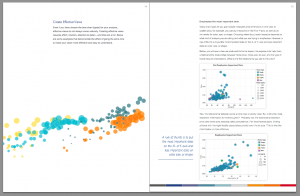Let me start this by being real straight here: your content needs to convert people into customers.
Yes, I know, most of us prefer to just write and make beautiful and useful content. What about all the knowledge and lives that it changed just by existing?
Well… at the end of the day, we are professionals, working in companies. If they don’t sell, they are not going to invest more in our educational content – and they won’t even have money to pay us.
So, we better do our parts to help our companies grow sales and ensure that we can pay our bills, too.
How can you make sure your content will not only teach, entertain, or solve the issues for the readers but also leave them one step closer to being part of your customer base?
I’ll give you some tips based on my experience trying to convert the 7 million worldwide readers that Rock Content attracts to its blogs every month.
And if you want to keep up with the latest trends in digital marketing, consider subscribing to our interactive newsletter below.
Organizing the workspace
To know what you can offer to your readers, you must be fully aware of what you have available.
At Rock Content, a global leader in content marketing, we have four content solutions plus an 80,000 freelancers talent network and a worldwide presence, especially in the US, Brazil, and Mexico (in other words, we work with three languages).
So, to make sure that all content editors that work in our blogs would know how to promote our lead gen assets, we:
- Documented all of them;
- Started increasing this documentation with all the promotional materials available for them.
This can be a super simple task or a Hercules’ job.
At Rock Content, it was more like the last one: at the end, we discovered that we have more than 300 landing pages for Ebooks, webinars, spreadsheets, demo requests, etc. in Portuguese. We also have around 150 in Spanish, and 120 in English.
Now we have all these assets documented in a big table like this:
| Language | Name of the Content | Content Type | Landing Page Link | Link to all promotional images | HTML code to insert the banner |
| EN | Example 1 | Webinar | example1.com | https://drive.google.com/drive/u/0/ | <a href=”https://example1.com” target=”_blank” rel=”noreferrer noopener”><img src=”https://example1.png”/></a> |
| PT | Example 2 | Ebook | example2.com | https://drive.google.com/drive/u/0/ |
Shifting the mindset from SEO optimized to SEO “and” conversion-optimized
At Rock Content, anyone that publishes content has already prepared it to be loved by Google. SEO is in our veins.
Since 2019, we initiated our internationalization process in the US, where we are growing 30% quarterly in traffic and have hundreds of thousands of monthly visits nowadays.
But, in Brazil and Mexico, where we have more maturity, Rock Content has millions of visitors and is positioned in first SERP’s places for important keywords such as SEO, Content Marketing, Digital Marketing, Inbound Marketing, etc.
But, to be quite honest, sometimes our blog team would forget to think about the rest of the journey: the offers that we could do to make the reader be a step closer to becoming a lead.
To solve that problem, as the Lead Gen Manager, I’ve trained the whole Marketing team, showing all the possibilities that they have to promote lead gen assets in a blog post.
With that, we’ve increased our lead generation by 30% quarter over quarter in the North American market and kept a 5% growth in Latin America.
Those are the tips that I’m going to share with you below:
You need to know your audience
Think about it: if you had to ask for a loan from your mother, how would you do it?
Would you use the same tactic and words if you had to do this request to your father?
Probably not, right?
Well, that’s because you deeply know them: habits, way of acting, likes, and dislikes. And that’s what you need to know to make sure you can ask for something from your reader (email address or any other type of data sent through a form).
To get to know your audience, you must talk to them! Go to events where they are, reach out to some of them to collect feedback, create a routine of weekly or monthly interviews. Besides that, you can also:
- Analyze web analytics;
- Capture easy-to-interpret click maps or heat maps;
- Use session-recording tools;
- Do frequent surveys to collect first-party data;
- Make A/B tests to understand what brings better results.
Understand what the visitor wants in that blog post
A good content briefing will probably highlight the keyword, the persona, for what stage in the customer journey it is being planned (top, middle, or bottom of the funnel), and a summary of the topics that it needs to have to successfully achieve the reader’s intention.
All of this information is also important when choosing the lead gen offer that you will display in the blog post.
If the offer doesn’t match the context, it will probably have a sad small conversion rate (if it has any!).
Diversify the offers and the paths that lead to them
We know that our content is not fully read 100% of the time. Depending on the reader’s needs, they will only scan the text, eager to find what they are looking for with the minimum amount of effort.
With that in mind, we need to make sure that we’ll have a call to action (CTA) and an offer for every type of reader.
If your text is about “Interactive Content” and you have a deep strong Ebook about it, for example, add CTAs to it more than once, and, if possible, in different styles:
- Text CTA;
- Banner
- Small video introducing the subject.
Everything counts!
Follow good practices about copywriting and UX
Readers tend to scan the content, looking for the sections that pertain to their research.
So if you are sure your lead gen offer is related to the text context and can help them, make sure to highlight it properly.
You can use bold, italic, bullet points, with larger letters or different colors. The important thing is to know what works for your audience.
Whenever it’s possible, work with psychological triggers to increase the chances of attracting leads. These mental triggers are stimuli received by our brain that directly influence our decision-making.
Some of the most common triggers for marketing content are:
- Social proof: “more than 10,000 people already downloaded this template”
- Scarcity: “subscribe now! we have limited spots available”
- Authority: “watch our latest webinar about it with the lead gen expert Marina Cordeiro”.
There are many more! The important thing here is to only use them when the information communicated is real.
Associate with White Label SEO solutions
There is also an extra possibility, and it is becoming an agency to manage all your clients with good content and SEO services.
Being this your case, how about to start or expand your services, by getting in touch with us to become a partner with White label SEO.
This way you provide SEO services to your customers, but without the need to hire specialized staff, invest in individual tools, or learn SEO from scratch.
Tools & Tactics for conversion
Now that I’ve shared some guidelines about how to prepare your text to be conversion-oriented, let’s dive deep into how you can put them into practice in your blog.
Image CTAs
Banners can be effective, but we must know how to work with them to avoid banner blindness.
The term banner blindness was coined in 1998 in an academic paper by Jan Panero Benway and David M. Lane. It is used to explain that users have learned to ignore content that:
- Resembles ads;
- Is close to ads;
- And/or appears in locations traditionally dedicated to ads.
It explains why you will see higher conversion rates from banners strategically placed inside a blog post (according to the context) than the ones that you can have in the sidebar of your blog layout.
Use them without exaggeration, as a way to give your reader a little rest from the big block of texts.
But if the content is already full of images, maybe it’s better to use text CTAs instead.
Text CTAs
Marketing writers usually know the importance of internal and external backlinks for SEO. But they often forget about how powerful those links can be for lead gen too.
Don’t make that mistake! When adding links inside your blog post, remember to include some for the landing pages of Ebooks, webinars, or any other lead gen offers too.
If you have personalized parameters to track the conversion path (or if you add UTMs), you will be able to see how much this can impact your lead gen efforts.
Using text CTAs inside the content is a great way to avoid banner blindness. To increase visibility, it’s better to create hyperlinks at the beginning of paragraphs, or at the very end of them. You might take advantage of the proximity with H2 titles as well.
Another suggestion is to implement “Get to know more” or “Related Content” paragraphs inside the text, including 3 or more links to relevant offers.
Templates
I’m calling this tactic “templates”, but it can be any type of rich content that you feel can help your reader.
It is super simple: look at your Google Analytics and find the most popular blog posts that you have. Now, read each and every one of them with user intent in mind. By doing so, you might find ideas for new lead gen offers that you can create and promote inside that content.
I got this insight from this blog post from Hubspot and noticed that other companies are also doing it when I read this newsletter from Sleeknote.
Here at Rock Content, I notice that our Portuguese blog post about SWOT analysis was always inside Google Analytics’ active users right now section, for example. And, of course, was on the top 10 blog posts in terms of sessions.
Printscreen of the Google Analytics console of Rock Content’s Portuguese blog showing the active users right now section.
Analyzing the blog post, the main keyword, and the secondary ones, I understood that the people that were getting into this blog post didn’t just want to know what was SWOT. They were probably trying to do a SWOT analysis by themselves.
So, how could I help them?
Well, I’ve built a template using Google Slides, so after reading the blog post and learning all steps necessary to do a SWOT analysis, they could quickly create a presentation with their main insights.
In the first month that I’ve applied this technique, we got more than 500 form submissions to download the template. And this value kept growing in the following months, improving the overall conversion rate of this blog post drastically.
I replicated this for “marketing plan”, “brainstorm activities”, “promotional email marketing” and many other blog posts. All of them achieved satisfactory results.
Pop-ups
Pop-ups are annoying yet effective. The trick here is to use them taking the context into consideration.
At Rock Content, the recipe for success was grouping blog posts according to the main theme and then creating a specific pop-up for that topic. In this way, we managed to gain scale without leaving personalization aside.
For example, we have more than 50 blog posts about Instagram. They cover topics like what is the perfect size for Instagram posts, how to create an Instagram business account, how to acquire followers, tips to increase engagement, the most famous accounts, and so on.
We have a really strong Ebook about marketing tactics for Instagram, so we grouped all those blog posts in our pop-up tool (Hello Bar) and started testing different pop-up formats and copies until we found the best conversion rate for the whole group.
Printscreen of Hello Bar settings for the Instagram cluster of Rock Content’s Portuguese blog.
We replicated this tactic for Facebook, LinkedIn, sales, content marketing, SEO, and several other topic clusters that we have in our blogs.
Before we started using this, we had just 1 pop-up for all blog posts, with a generic offer, converting around 1,8% of the blog visitors into leads. After the creation of personalized pop-ups, this number went to 9% on average. Impressive, right?
Final checklist
OK! Now you are ready to create content optimized for SEO and conversion.
To always remember all the tips that we discussed here, make sure to follow this checklist:
- Open the document where you have all your lead gen offers documented;
- Take the blog post context into consideration when choosing which CTAs to include;
- Add more than one offer;
- Add more than one path to the main offer;
- If the keyword is educational, check if you can create a lead gen offer specifically for it (ex: templates or quick step-by-step guides);
- Make sure the blog post has a personalized pop-up promoting content related to its main topic.
There you go! You are ready to press “publish” and make the lead capture process feel like a natural next step for the reader – and your company increases its sales!
This article was originally published in the Search Engine Journal ebook “Perfectly Optimized Content From Start to Finish“. It’s an awesome read, download it right now!
2024 State of Marketing Report
Your golden ticket to crush your goals with data-driven insights!
2024 State of Marketing Report
Your golden ticket to crush your goals with data-driven insights!

![[Rock NA] Blog Post Templates Blog Post Templates - Download Now](https://rockcontent.com/wp-content/uploads/2022/08/Copy-of-Blogpost-banner-750×-200.png)






